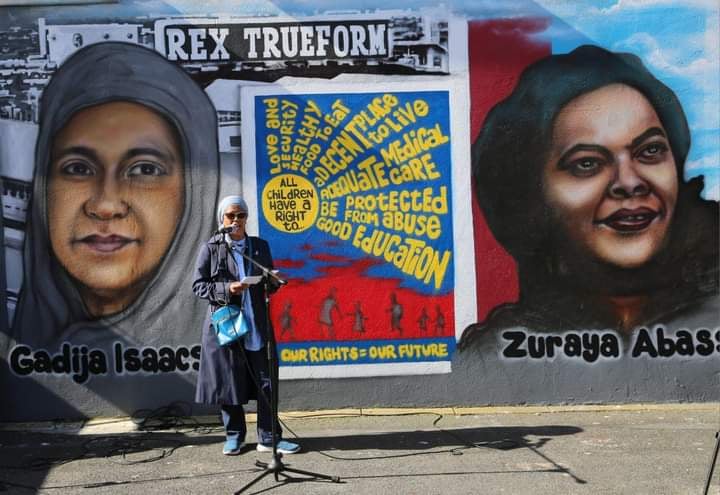PRESERVING CAPE HERITAGE AND CULTURE THROUGH EXPLORING VISUAL ARTS AND EDUCATION
Daughters of Salt River
Feature writer Imān Zanele Omar shares more on the women of Salt River and the great roles they played
THROUGH YOUR PEN
Imān Zanele Omar
10/7/20246 min read


Celebrating our 68th National Women’s Day this year, I’ve been deeply reflecting on how this significant event has impacted my own gendered experience growing up as a ‘coloured’ woman from the Born-Free Generation, exactly 40 years after the commemoration of the Women’s League March of 1956. There’s no question that these brave women pioneered a movement to break down the most vital barriers to women’s rights in this country and enabled us to thrive in the freedoms that exist for us today. However, 68 years later we as women still find ourselves fighting for equity with regards to equal pay in the workplace, traditional social constructs and cultural roles of women, especially women of colour as well as the threat of gender-based violence.
As a young woman, it sometimes feels frustrating that we are still having to fight for basic equal opportunities and recognition in society today, which women 68 years ago and beyond were doing. So, in my attempt to draw inspiration from my female ancestors, I decided to look deeper into the contribution and impact of the women who not only advocated for our constitutional rights but also those who unapologetically initiated themselves into roles of power in our broader community. In doing so, I decided that the best place to start such a reflection is to look within my own community of Salt River where I am the 6th generation to have grown up in this area and in my ancestral home.
Salt River is one of the oldest inner-city suburbs of Cape Town, sandwiched between the bustling communities of Woodstock and Observatory. It is a community rich in its cultural heritage both tangible and intangible, as well as its anti-apartheid struggle legacy. It is currently a rapidly changing community absorbing an increasing number of new arrivals from Europe, America, and various African communities trying to make a home here. It is a microcosm of the new democratic South Africa emerging. Today, Salt River is a diverse community of people, living side by side, connecting its past and its present in shaping a culturally diverse future. However, Salt River is also home to some of the most resilient and influential women leaders in Cape Town, like Gadija Isaacs, Gladys Thomas, Zurayah Abass and Karima Brown.
Gadija Isaacs (1907-1990), the first woman I grew up hearing about, was born in Kimberley in the Northern Cape and later moved to Salt River with her daughter in the early 1950s. A fierce leader, Gadija worked as a machinist at Rex Trueform shortly after moving to Cape Town. Hardworking and tenacious, she was elected as a Shop Steward in the Garment Workers Union. She thrived in this role and was elected to serve on the Consultative Committee. She was the very first woman of colour to hold a seat on the executive of the Industrial Council as well as a trustee. Gadija was dedicated to her role by not only fighting for the rights of marginalised workers but also educating workers about the importance of trade unionism. She worked tenaciously to improve workers’ conditions and played an important role in securing bursaries for workers’ children to study at university. Her unwavering commitment in representing her community and those she worked with, as well as creating opportunities for her colleagues and their families to advance in an environment of apartheid, is nothing less than inspiring.
Gladys Thomas (1934-2022), another inspiring woman born in Salt River to a mixed-race couple, was an award-winning poet, playwright and short-story writer. Her early life was split between Salt River and Lakeside. She later settled in Simonstown with her husband and two kids where she was evicted and forcibly removed to the Ocean View township as a result of the draconian Group Areas Act. This traumatic experience inspired her to channel her suffering into writing as a means to process her reality but also as a means to communicate to her children and the broader South African community the impact of what was happening to them and why. In 1972 she published an anthology called “Cry Rage!” which was then banned by the apartheid government two weeks after its launch.
She continued to fight against the political injustices and oppression around her through her writing and art, the latter of which became internationally renowned for its raw and authentic depiction of the suffering of people of colour under apartheid South Africa. After the abolition of apartheid, Gladys continued to use her art and expertise to uplift her community by creating opportunities for youth and persevered with her practice of speaking up for marginalised communities by highlighting the HIV/AIDS epidemic among other significant issues faced in this country. Gladys’s life story reveals the unwavering determination and perseverance she held in depicting the cruel inequality faced by black people despite the threats and risks under the apartheid system at the time. Her commitment to her community and her people throughout her life is not only inspiring, but also comforting in that she not only came from this community, and broke barriers herself, but also assisted others to break them too.
Zurayah Abass (1953-2003) is another iconic woman from Salt River, who played a key role in the anti-apartheid struggle. Zurayah, the only sister, took up the responsibility of caring for her younger siblings after the death of her mother. Despite her circumstances and the countless obstacles she faced, Zurayah completed high school and qualified as a bookkeeper. She remained conscious of the political situation in the country and joined various community organisations like the United Women’s Organisation, the United Democratic Front as well as the African National Congress. Zurayah is a founding member of Molo Songololo, a child’s rights organisation that promotes the safety and rights of children from diverse communities. This organisation, which is still in existence today, helps underprivileged children with various educational assistance, to advance themselves and create better opportunities despite their socio-economic backgrounds.
Zurayah’s social and political activities were viewed as a substantial political threat to the apartheid government, which ultimately led to her arrest in 1987. Undeterred, and inspired by her aspiration for social change, after her release from prison Zurayah continued to advocate for children’s rights until the end of her life in 2003. This incredible woman took the unfortunate circumstances of her own lived experience and challenged it into uplifting the youth in her community and ultimately all-around South Africa, the legacy of which is still being felt via Molo Songolo currently. Her contribution not only impacted the lives of thousands of young people but also translated into legislation for the rights of children in our South African constitution - talk about breaking glass ceilings.
Another remarkable woman from Salt River who captured my attention was Karima Brown (1967-2021), who was well-known and widely admired for her fearless and tenacious journalism that sought to hold those in power to account, highlight stories of public interest and give voice to the marginalised. She made waves in the media industry by being a journalist with an unapologetic political activist bent. Through her advocacy, she was deeply involved in championing social justice by uniquely connecting her work through conscious storytelling and political journalism. Growing up watching her on television, had a huge impact on me as a young girl who also had strong roots in Salt River and her representation strongly encouraged my own pursuit and aspirations of writing and storytelling.
The stories of these four women specifically drew me in through their resilience and determination in the ways in which they pushed boundaries and opened doors for my generation to be able to walk through with confidence. These women wholeheartedly spoke truth to power, became the leaders in their own time and created opportunities for those in their own communities to break the barriers of the status quo. The hardships and challenges faced by each of these women only fueled their passion for promoting social change further.
Ultimately through this personal journey of discovery into searching for inspiration from these daughters of Salt River, I found more than that. I found a kinship with the compassion, the resilience and the determination that each of these women held. As a daughter of Salt River, myself, the stories of these iconic women have ignited my passion for social change, community building and continuing to build on the legacies that they have created. It’s needless to say that in this pursuit, my generation of women has big shoes to fill but we’re extremely fortunate that the paths have already been beautifully paved by those before us.
Images by: Imān Zanele Omar
Imān Zanele Omar


Discover
Contact Us
Our cultural heritage matters
Help us learn and grow by sharing your respectful feedback on our website, exhibitions, social media and more:
Store's Terms and Conditions
